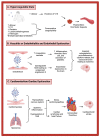Pathomechanisms and Treatment Implications for Stroke in COVID-19: A Review of the Literature
- PMID: 35207494
- PMCID: PMC8877423
- DOI: 10.3390/life12020207
Pathomechanisms and Treatment Implications for Stroke in COVID-19: A Review of the Literature
Abstract
Stroke in patients with COVID-19 has received increasing attention throughout the global COVID-19 pandemic, perhaps due to the substantial disability and mortality that can result when the two conditions co-occur. We reviewed the existing literature and found that the proposed pathomechanism underlying COVID-19-associated ischemic stroke is broadly divided into the following three categories: vasculitis, endothelialitis, and endothelial dysfunction; hypercoagulable state; and cardioembolism secondary to cardiac dysfunction. There has been substantial debate as to whether there is a causal link between stroke and COVID-19. However, the distinct phenotype of COVID-19-associated strokes, with multivessel territory infarcts, higher proportion of large vessel occlusions, and cryptogenic stroke mechanism, that emerged in pooled analytic comparisons with non-COVID-19 strokes is compelling. Further, in this article, we review the various treatment approaches that have emerged as they relate to the proposed pathomechanisms. Finally, we briefly cover the logistical challenges, such as delays in treatment, faced by providers and health systems; the innovative approaches utilized, including the role of tele-stroke; and the future directions in COVID-19-associated stroke research and healthcare delivery.
Keywords: COVID-19; SARS-CoV-2; acute ischemic stroke; cryptogenic stroke; intracerebral hemorrhage; management of stroke; pathomechanism stroke; pathomechanisms; pathophysiology; treatments.
Conflict of interest statement
The authors declare no conflict of interest.
Figures



Similar articles
-
Recent Updates on COVID-19 Associated Strokes.Neurosci Insights. 2024 Oct 8;19:26331055241287730. doi: 10.1177/26331055241287730. eCollection 2024. Neurosci Insights. 2024. PMID: 39391859 Free PMC article. Review.
-
Ischemic stroke of unclear aetiology: a case-by-case analysis and call for a multi-professional predictive, preventive and personalised approach.EPMA J. 2022 Nov 17;13(4):535-545. doi: 10.1007/s13167-022-00307-z. eCollection 2022 Dec. EPMA J. 2022. PMID: 36415625 Free PMC article.
-
Pathomechanism and Management of Stroke in COVID-19: Review of Immunopathogenesis, Coagulopathy, Endothelial Dysfunction, and Downregulation of ACE2.J Clin Neurol. 2021 Apr;17(2):155-163. doi: 10.3988/jcn.2021.17.2.155. J Clin Neurol. 2021. PMID: 33835735 Free PMC article. Review.
-
Correlation Between Hypercoagulable State and Severity Level of Ischemic Stroke With Covid-19 Infection.J Blood Med. 2023 Oct 11;14:537-542. doi: 10.2147/JBM.S429357. eCollection 2023. J Blood Med. 2023. PMID: 37849564 Free PMC article.
-
COVID-19 and ischemic stroke.Eur J Neurol. 2021 Nov;28(11):3826-3836. doi: 10.1111/ene.15008. Epub 2021 Jul 17. Eur J Neurol. 2021. PMID: 34224187 Free PMC article. Review.
Cited by
-
The Neurological Implications of COVID-19: A Comprehensive Narrative Review.Cureus. 2024 May 15;16(5):e60376. doi: 10.7759/cureus.60376. eCollection 2024 May. Cureus. 2024. PMID: 38887342 Free PMC article. Review.
-
Household income is associated with functional outcomes in a multi-institutional cohort of patients with ischemic stroke and COVID-19.J Stroke Cerebrovasc Dis. 2023 May;32(5):107059. doi: 10.1016/j.jstrokecerebrovasdis.2023.107059. Epub 2023 Feb 20. J Stroke Cerebrovasc Dis. 2023. PMID: 36842351 Free PMC article.
-
Genetic Architecture of Ischaemic Strokes after COVID-19 Shows Similarities with Large Vessel Strokes.Int J Mol Sci. 2023 Aug 30;24(17):13452. doi: 10.3390/ijms241713452. Int J Mol Sci. 2023. PMID: 37686257 Free PMC article.
-
Stroke in the COVID-19 pandemic era.Postep Psychiatr Neurol. 2022 Jun;31(2):69-73. doi: 10.5114/ppn.2022.116881. Epub 2022 Jun 1. Postep Psychiatr Neurol. 2022. PMID: 37082091 Free PMC article. Review.
-
Ischemic Stroke in a SARS-CoV-2-Positive Octagenarian Without Cardiovascular Risk Factors: A Case Report.Cureus. 2022 Mar 30;14(3):e23654. doi: 10.7759/cureus.23654. eCollection 2022 Mar. Cureus. 2022. PMID: 35505709 Free PMC article.
References
Publication types
LinkOut - more resources
Full Text Sources
Miscellaneous

